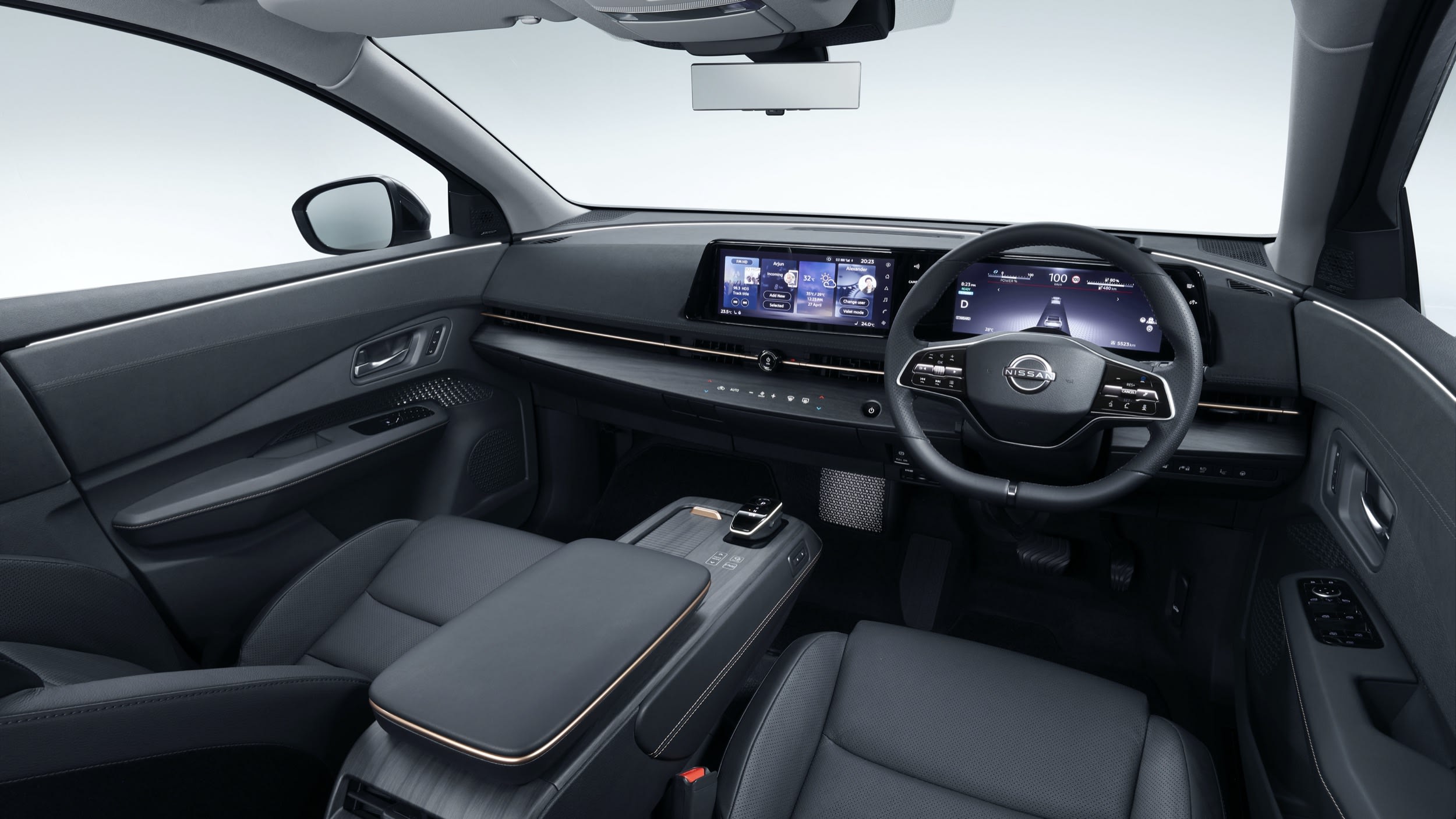Not quite a year ago, Nissan showed its Ariya electric crossover concept with a clean, elegant design inside and out. And as it turns out, the production 2022 Nissan Ariya, just revealed, looks exactly like it. It’s also boasting some impressive numbers.
From the outside, the concept and production model are almost indistinguishable. They each feature a smooth, glossy panel at the front in place of a traditional grille, with a textured panel underneath and accent lighting in the badges and running lights descending the edges of the “grille.” The same curvy profile and two-tone paint scheme sticks around, and from the side, the only differences are a less well-integrated charger cover and possibly longer overhangs. Even the wheels are the same smooth, minimalist design.
More important, the interior remains basically the same. It’s an airy cabin with a minimalist dashboard that features full-length air vent trim and dual 12.3-inch screens for instruments and navigation. The concept’s capacitive buttons under the faux wood trim even made it to production, creating a futuristic but warm feeling in the cabin. Nissan also opened up the entire area under the dash by moving climate control equipment under the hood. There’s a storage compartment down there as well as a fold-out tray table. Other striking details include a wrap-around line of ambient light at the top of the dash and door panels, a two-spoke steering wheel and backlit door trim.
As cool as the crossover looks, it needs a powertrain to back it up, and Nissan will offer two, each available with two different-size batteries all packaged into a new modular platform that will underpin future Nissan EVs. The entry-level Ariya will have a single motor powering the front wheels and producing 215 horsepower and 221 pound-feet of torque. Above that is the all-wheel-drive model with two motors. This uses the e-4ORCE system we’ve tried out in Leaf prototypes. In the Ariya, total output will be 389 horsepower and 443 pound-feet of torque. As to why the Ariya’s single-motor layout will be front-wheel drive rather than rear-wheel drive as with competitors such as VW, Nissan executives noted that front-drive was selected for the Ariya to provide familiar, friendly handling for drivers who are not as experienced. Additionally, there are packaging conveniences with having all the equipment up front.
As for the batteries, entry-level battery pack is a 63-kWh unit, and an optional 87-kWh unit is available, each mounted in the floor. Nissan has only given a range estimate for the front-drive 87-kWh model, which will go the farthest at approximately 300 miles, and that’s based on the EPA test. Based on other EVs with battery packs in the 60- to 65-kWh capacity range, we would expect a front-drive Ariya with the 63-kWh battery to have a range in the low 200-mile region. The Ariya’s battery packs will also be liquid-cooled, unlike the air-cooled unit in the Leaf. The all-wheel-drive version won’t have as much range as the front-drive version, and it also intrudes on cargo space, shrinking the cargo area from 16.5 cubic feet to 14.6.
Nissan will also offer plenty of technology in the Ariya. It comes standard with wireless Apple CarPlay and Android Auto, as well as Amazon Alexa integration. It will be the first Nissan with over-the-air updating. In addition to the dual screens, it will have a full-color heads-up display. Front and rear automatic emergency braking, lane-departure warning, blind-spot monitoring, rear cross-traffic alert and automatic high-beam headlights are standard, too. The second-generation ProPilot Assist with hands-free single-lane highway driving will be available as an option.
Despite being revealed with many details, we’ll be waiting a little while for the Ariya to go on sale. It’s slated for late 2021. Pricing will start around $40,000 for the base model, and it should be eligible for a federal tax credit.
Related Video:

